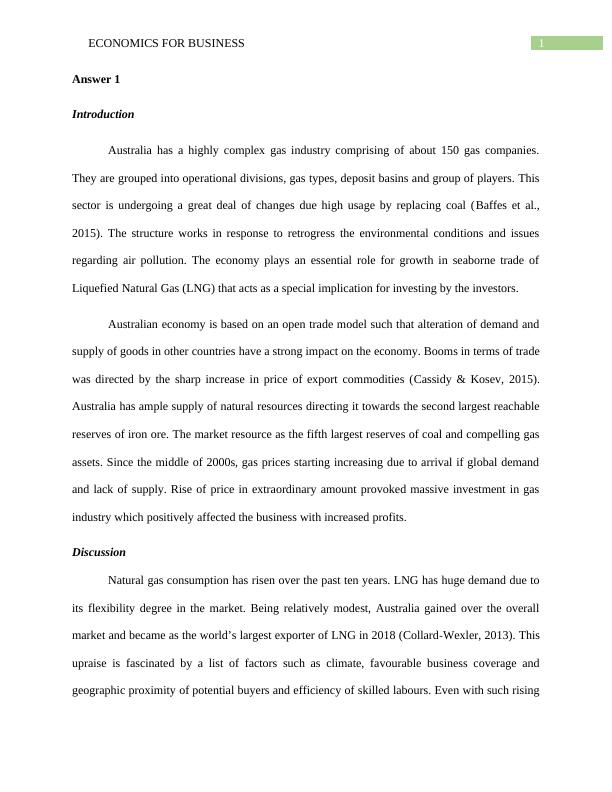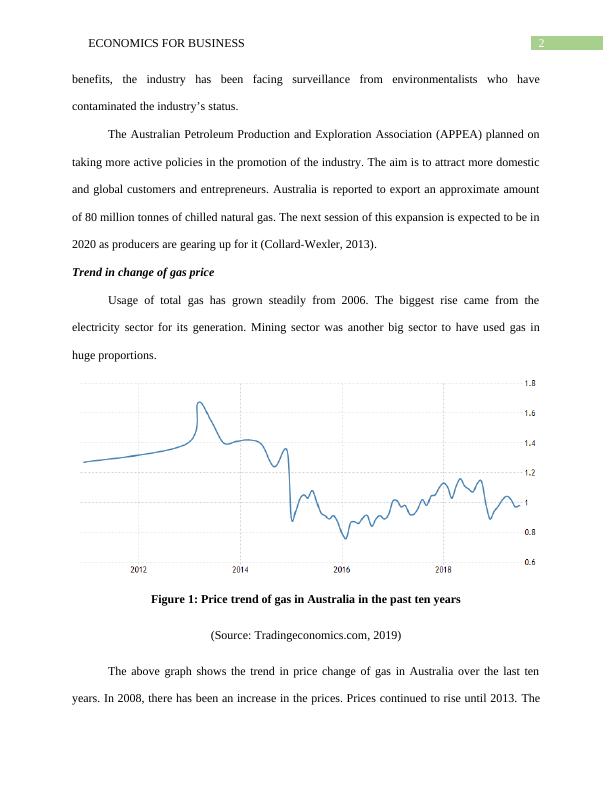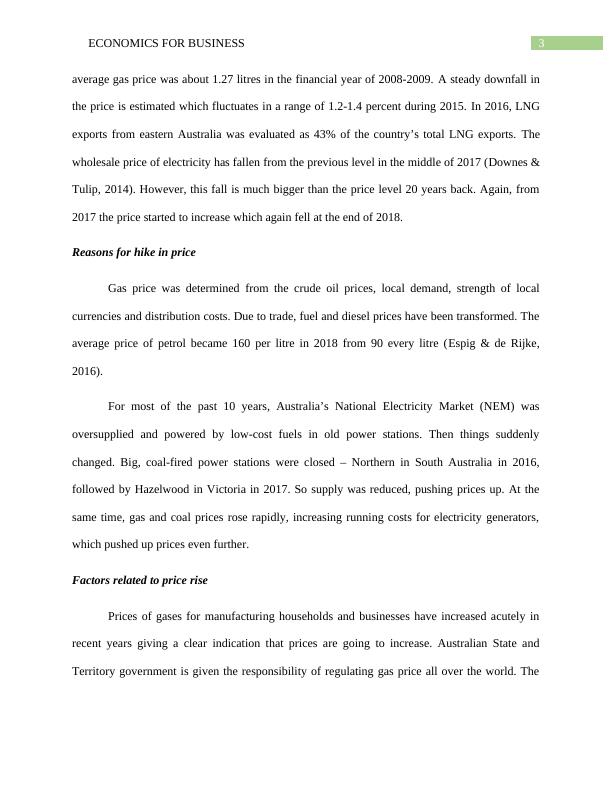Business Economics Assignment 2022
Added on 2022-09-30
20 Pages5324 Words32 Views
Running head: ECONOMICS FOR BUSINESS
Economics for Business
Name of the Student
Name of the University
Course ID
Economics for Business
Name of the Student
Name of the University
Course ID

1ECONOMICS FOR BUSINESS
Answer 1
Introduction
Australia has a highly complex gas industry comprising of about 150 gas companies.
They are grouped into operational divisions, gas types, deposit basins and group of players. This
sector is undergoing a great deal of changes due high usage by replacing coal (Baffes et al.,
2015). The structure works in response to retrogress the environmental conditions and issues
regarding air pollution. The economy plays an essential role for growth in seaborne trade of
Liquefied Natural Gas (LNG) that acts as a special implication for investing by the investors.
Australian economy is based on an open trade model such that alteration of demand and
supply of goods in other countries have a strong impact on the economy. Booms in terms of trade
was directed by the sharp increase in price of export commodities (Cassidy & Kosev, 2015).
Australia has ample supply of natural resources directing it towards the second largest reachable
reserves of iron ore. The market resource as the fifth largest reserves of coal and compelling gas
assets. Since the middle of 2000s, gas prices starting increasing due to arrival if global demand
and lack of supply. Rise of price in extraordinary amount provoked massive investment in gas
industry which positively affected the business with increased profits.
Discussion
Natural gas consumption has risen over the past ten years. LNG has huge demand due to
its flexibility degree in the market. Being relatively modest, Australia gained over the overall
market and became as the world’s largest exporter of LNG in 2018 (Collard‐Wexler, 2013). This
upraise is fascinated by a list of factors such as climate, favourable business coverage and
geographic proximity of potential buyers and efficiency of skilled labours. Even with such rising
Answer 1
Introduction
Australia has a highly complex gas industry comprising of about 150 gas companies.
They are grouped into operational divisions, gas types, deposit basins and group of players. This
sector is undergoing a great deal of changes due high usage by replacing coal (Baffes et al.,
2015). The structure works in response to retrogress the environmental conditions and issues
regarding air pollution. The economy plays an essential role for growth in seaborne trade of
Liquefied Natural Gas (LNG) that acts as a special implication for investing by the investors.
Australian economy is based on an open trade model such that alteration of demand and
supply of goods in other countries have a strong impact on the economy. Booms in terms of trade
was directed by the sharp increase in price of export commodities (Cassidy & Kosev, 2015).
Australia has ample supply of natural resources directing it towards the second largest reachable
reserves of iron ore. The market resource as the fifth largest reserves of coal and compelling gas
assets. Since the middle of 2000s, gas prices starting increasing due to arrival if global demand
and lack of supply. Rise of price in extraordinary amount provoked massive investment in gas
industry which positively affected the business with increased profits.
Discussion
Natural gas consumption has risen over the past ten years. LNG has huge demand due to
its flexibility degree in the market. Being relatively modest, Australia gained over the overall
market and became as the world’s largest exporter of LNG in 2018 (Collard‐Wexler, 2013). This
upraise is fascinated by a list of factors such as climate, favourable business coverage and
geographic proximity of potential buyers and efficiency of skilled labours. Even with such rising

2ECONOMICS FOR BUSINESS
benefits, the industry has been facing surveillance from environmentalists who have
contaminated the industry’s status.
The Australian Petroleum Production and Exploration Association (APPEA) planned on
taking more active policies in the promotion of the industry. The aim is to attract more domestic
and global customers and entrepreneurs. Australia is reported to export an approximate amount
of 80 million tonnes of chilled natural gas. The next session of this expansion is expected to be in
2020 as producers are gearing up for it (Collard‐Wexler, 2013).
Trend in change of gas price
Usage of total gas has grown steadily from 2006. The biggest rise came from the
electricity sector for its generation. Mining sector was another big sector to have used gas in
huge proportions.
Figure 1: Price trend of gas in Australia in the past ten years
(Source: Tradingeconomics.com, 2019)
The above graph shows the trend in price change of gas in Australia over the last ten
years. In 2008, there has been an increase in the prices. Prices continued to rise until 2013. The
benefits, the industry has been facing surveillance from environmentalists who have
contaminated the industry’s status.
The Australian Petroleum Production and Exploration Association (APPEA) planned on
taking more active policies in the promotion of the industry. The aim is to attract more domestic
and global customers and entrepreneurs. Australia is reported to export an approximate amount
of 80 million tonnes of chilled natural gas. The next session of this expansion is expected to be in
2020 as producers are gearing up for it (Collard‐Wexler, 2013).
Trend in change of gas price
Usage of total gas has grown steadily from 2006. The biggest rise came from the
electricity sector for its generation. Mining sector was another big sector to have used gas in
huge proportions.
Figure 1: Price trend of gas in Australia in the past ten years
(Source: Tradingeconomics.com, 2019)
The above graph shows the trend in price change of gas in Australia over the last ten
years. In 2008, there has been an increase in the prices. Prices continued to rise until 2013. The

3ECONOMICS FOR BUSINESS
average gas price was about 1.27 litres in the financial year of 2008-2009. A steady downfall in
the price is estimated which fluctuates in a range of 1.2-1.4 percent during 2015. In 2016, LNG
exports from eastern Australia was evaluated as 43% of the country’s total LNG exports. The
wholesale price of electricity has fallen from the previous level in the middle of 2017 (Downes &
Tulip, 2014). However, this fall is much bigger than the price level 20 years back. Again, from
2017 the price started to increase which again fell at the end of 2018.
Reasons for hike in price
Gas price was determined from the crude oil prices, local demand, strength of local
currencies and distribution costs. Due to trade, fuel and diesel prices have been transformed. The
average price of petrol became 160 per litre in 2018 from 90 every litre (Espig & de Rijke,
2016).
For most of the past 10 years, Australia’s National Electricity Market (NEM) was
oversupplied and powered by low-cost fuels in old power stations. Then things suddenly
changed. Big, coal-fired power stations were closed – Northern in South Australia in 2016,
followed by Hazelwood in Victoria in 2017. So supply was reduced, pushing prices up. At the
same time, gas and coal prices rose rapidly, increasing running costs for electricity generators,
which pushed up prices even further.
Factors related to price rise
Prices of gases for manufacturing households and businesses have increased acutely in
recent years giving a clear indication that prices are going to increase. Australian State and
Territory government is given the responsibility of regulating gas price all over the world. The
average gas price was about 1.27 litres in the financial year of 2008-2009. A steady downfall in
the price is estimated which fluctuates in a range of 1.2-1.4 percent during 2015. In 2016, LNG
exports from eastern Australia was evaluated as 43% of the country’s total LNG exports. The
wholesale price of electricity has fallen from the previous level in the middle of 2017 (Downes &
Tulip, 2014). However, this fall is much bigger than the price level 20 years back. Again, from
2017 the price started to increase which again fell at the end of 2018.
Reasons for hike in price
Gas price was determined from the crude oil prices, local demand, strength of local
currencies and distribution costs. Due to trade, fuel and diesel prices have been transformed. The
average price of petrol became 160 per litre in 2018 from 90 every litre (Espig & de Rijke,
2016).
For most of the past 10 years, Australia’s National Electricity Market (NEM) was
oversupplied and powered by low-cost fuels in old power stations. Then things suddenly
changed. Big, coal-fired power stations were closed – Northern in South Australia in 2016,
followed by Hazelwood in Victoria in 2017. So supply was reduced, pushing prices up. At the
same time, gas and coal prices rose rapidly, increasing running costs for electricity generators,
which pushed up prices even further.
Factors related to price rise
Prices of gases for manufacturing households and businesses have increased acutely in
recent years giving a clear indication that prices are going to increase. Australian State and
Territory government is given the responsibility of regulating gas price all over the world. The

End of preview
Want to access all the pages? Upload your documents or become a member.
Related Documents
HI5003 - Economics - Demand and Supply of LNG in Australialg...
|7
|1463
|43
Mining Industry in Australia: A Case Study of BHP Billiton and Iron Ore Marketlg...
|13
|2601
|252
Application of Demand and Supply in the Australian Market Essay 2022lg...
|12
|2817
|24
Analysis of Natural Gas Market in Australialg...
|11
|1721
|226
ECON 3008 - Demand-Supply Management Of Resources In Australia Paperlg...
|8
|1477
|47
The University Economics Name of the Student Namelg...
|14
|3364
|78
